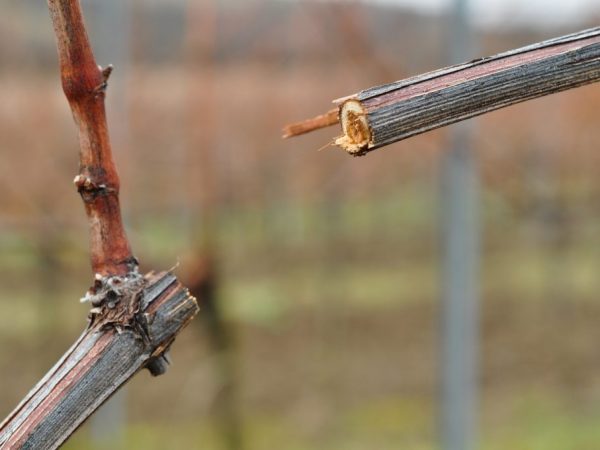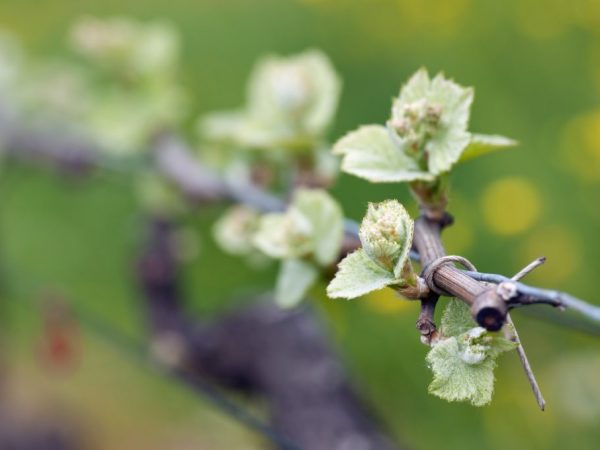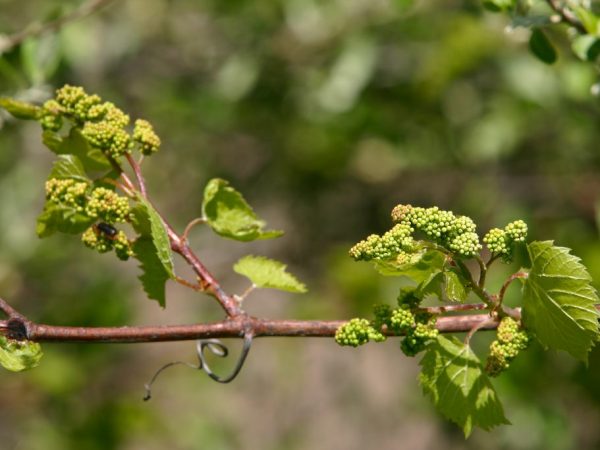Grape grafting rules in spring
Using various methods of grape propagation, it is possible not only to influence the development of the culture, but even to preserve the variety after damage to the trunk. The most important activity is the grafting of the grapes in the spring.

Grape grafting rules in spring
Why grapes are grafted in the spring
There are many benefits to grafting grapes in spring. With a properly organized procedure, you can not only have a beneficial effect on the yield of the crop, but also save space in the garden area, increasing the variety of varieties.
Due to active sap flow, the rootstock and scion survival rate is more effective. After the trimming has been carried out, the cut points formed are covered with liquid. So the grapes cry. It is this juice secreted by the plant that promotes better engraftment of the cutting, additionally disinfecting it.
With the help of grafting, you can both rejuvenate the vineyard and improve its immunity to diseases and pests. It is also important that after the carried out agrotechnical procedure, the ripening of the crop occurs much earlier. For novice growers, grafting is a good way to shorten the time it takes to harvest, so you can enjoy the flavor of your field-grown berries faster.
Favorable timing
The favorable timing of grafting grapes in spring is often determined by the climatic characteristics of the region in which the crop is grown.
When planting a plant, it is important that the soil warms up well by the time of grafting. Experts are sure that it is possible to start working in the garden when the temperature outside during the day is at least 15 ° C, and the ground temperature is 10 ° C.
There is some disagreement among gardeners about the best time to arrange vaccinations. Some adhere to the theory that it is necessary to carry out the procedure while the plant is crying, while others - after it. It will not be possible to find out the exact answer, because depending on a combination of factors (method of vaccination, climatic conditions, growing region, etc.), the result can be either positive or negative.
In temperate climates, plants are taken to be grafted no earlier than the second decade of April. Favorable terms may end in the second week of May. The only thing to consider is the absence of hot weather. Under such weather conditions, the risk of poor survival of the scion and rootstock increases.
Recommendations for beginner winegrowers

Inoculate grapes of the same color
There are many nuances that a novice gardener should consider before breeding a culture. So, the result of inoculation depends on what characteristics the scion and rootstock will have. There are several ways of grafting grapes in the spring:
- Black to black. This method is often used in springtime. Its peculiarity is that the grafting of the cuttings from the last year's shoot to the last year's stock is carried out.
- Black to green. A stalk prepared in the fall of last year is grafted onto a blossoming vine.
- Green to green. Blooming grafting materials are used.
For beginners, the best way is black to black. It is the lightest and most efficient. The main thing is to take into account some agrotechnical nuances and perform the procedure in warm, calm weather.
Harvesting cuttings and preparing rootstocks
Prepare to plant the culture should be in the fall. During this period, it is important to prepare cuttings. The choice of the variety is up to the gardener. It is better to give preference to high-yielding varieties. The workpiece itself is made like this:
- prepare a clean sharp knife and disinfect it with an alcohol-containing solution;
- cut the cuttings from the bush so that they have several eyes; the cut is performed at an angle of 45 °; approximate length - 10-13 cm;
- cuttings for 1 minute are placed in a 3% solution of copper sulfate for disinfection.
After disinfection, parts of the plant are dried on any flat surface at room temperature. After that, the cuttings are wrapped in a damp cloth and stored in a cool dry place.
It is important for novice winegrowers to choose a stock that is suitable for grafting. The best option is a vigorous, disease-resistant bush that is 3-5 years old. It is not recommended to use an old plant as a rootstock due to poor survival results.
Spring grafting methods

Achieving a good harvest is easy when done right.
There are several methods of grafting grapes that can be done in the spring.
The simplest ways are:
- grafting of grapes into the split;
- vaccination on a black head;
- grafting into the stem;
- grafting using a drill.
Each of these methods has features that must be taken into account when growing a crop. It is important that not only the engraftment of the scion and rootstock, but also the fertility of the renewed bush depends on the correctness of such procedures.
Into the cleft
Before starting this procedure, it is important to prepare all the necessary tools and materials. The faster the breeding method is organized, the more chances for a good result. The grafting process itself consists of stages:
- The rootstock is cleared of foliage (if any) and the junction with the rootstock is marked. The best place is the distance between the second and third kidney.
- The top of the vine is cut at a distance of 5 cm to the bud.
- A longitudinal incision (split) is made from the side of the second kidney.
- A prepared stalk is inserted into the split.
- A soft splint is applied to the joint.
The bandaged area takes root at an air temperature of 20-25 ° C.
When performing the procedure, it is important not to touch the cut sites with your hands, so as not to infect. It is best to use alcohol-containing solutions for such operations, to process garden tools and the designated areas where grafting into the split is performed.
In the bole
The stem is a simple and effective method of propagation, a feature of which is the ability to plant several cuttings at the same time. The procedure itself is performed like this:
- Dig the earth around the bush until the first node is visible.
- At a distance of 4-5 cm from the eye, the entire upper part of the plant is cut off.
- Split the bole to a depth of 3-4 cm (you can fully deepen the cutting).
- The mother plant is coated with plasticine, wrapped in polyethylene and sprinkled with a layer of earth 3-4 cm.
This method is similar to grafting on a black head. The only difference is the need to use prepared cuttings. It is also important that each of them should have 3 eyes.
Using a drill
A conventional drill bit helps to propagate the culture correctly.
The procedure is the same as in the previous method. The trunk of the bush is cut off a few centimeters from the surface of the earth. Holes are made in the trunk for future cuttings.
The drill diameter must match the cuttings.There should not be large gaps. The depth of the holes is 2-3 cm. After the scion is immersed, the grafted plant junction is sprinkled with sawdust and covered with plastic wrap. During the period of sap flow, such a procedure is not advised.
On a black head
This method is effective. Its goal is to get the first harvest from a renewed bush in 3 years. It begins to be carried out in the fall. The aboveground part of the stem of the plant is completely removed before wintering.
In the spring, holes are dug around the resulting stump and part of the root stem is cut off. After sprinkling the plants with soil, they are waiting for the result. Young shoots appear at the cut site after a few weeks. Weak shoots are removed from the grafted bush, and the stronger ones are pinched.
Caring for grapes after grafting
The growth and development of a grafted plant depends on the quality of its care.
It is important to pay attention to some features that help the graft to take root in a new place. After vaccination, you must:
- Water the plant and loosen the soil near the headquarters. The last procedure is carried out to obtain the required amount of oxygen by the bush.
- Examine the stock 2 weeks after the procedure. The lack of sprouting of the eyes indicates a poor vaccination result. Re-grafting may be required. This result is more often seen when using the black-to-black method.
- Control the process of engraftment of the cutting. Roots may appear that do not germinate in the stock. They should be removed.
In the spring, grafting a plant is more effective, since with the beginning of sap flow, the root system releases a large amount of nutrients to the shoots. You won't have to wait long for the result. After 2-3 weeks, you can determine whether the scion and rootstock have grown together or not.
Conclusion
Experts recommend grafting plants in the black-to-black method, which consists in the junction of last year's scion and rootstock. It is best to carry out grafting while the plant is crying or at the end of it, after pruning: this way the plant will have enough strength for the cutting to take root and independently disinfect the joint between the scion and the stock.


